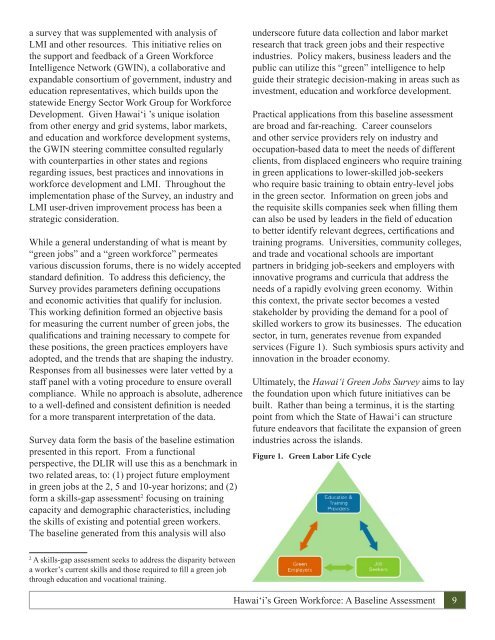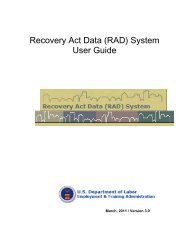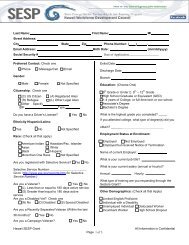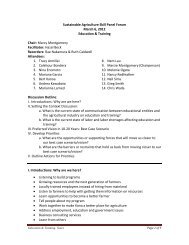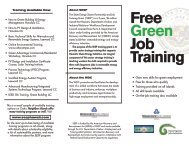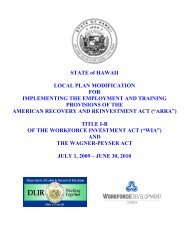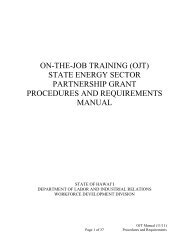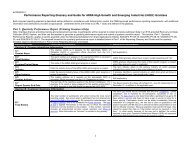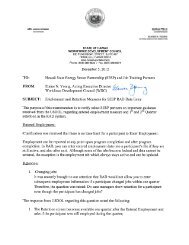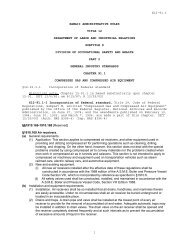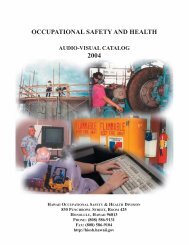Hawai i's Green Workforce A Baseline Assessment December 2010
Hawai i's Green Workforce A Baseline Assessment December 2010
Hawai i's Green Workforce A Baseline Assessment December 2010
You also want an ePaper? Increase the reach of your titles
YUMPU automatically turns print PDFs into web optimized ePapers that Google loves.
a survey that was supplemented with analysis of<br />
LMI and other resources. This initiative relies on<br />
the support and feedback of a <strong>Green</strong> <strong>Workforce</strong><br />
Intelligence Network (GWIN), a collaborative and<br />
expandable consortium of government, industry and<br />
education representatives, which builds upon the<br />
statewide Energy Sector Work Group for <strong>Workforce</strong><br />
Development. Given <strong>Hawai</strong>‘i ’s unique isolation<br />
from other energy and grid systems, labor markets,<br />
and education and workforce development systems,<br />
the GWIN steering committee consulted regularly<br />
with counterparties in other states and regions<br />
regarding issues, best practices and innovations in<br />
workforce development and LMI. Throughout the<br />
implementation phase of the Survey, an industry and<br />
LMI user-driven improvement process has been a<br />
strategic consideration.<br />
While a general understanding of what is meant by<br />
“green jobs” and a “green workforce” permeates<br />
various discussion forums, there is no widely accepted<br />
standard definition. To address this deficiency, the<br />
Survey provides parameters defining occupations<br />
and economic activities that qualify for inclusion.<br />
This working definition formed an objective basis<br />
for measuring the current number of green jobs, the<br />
qualifications and training necessary to compete for<br />
these positions, the green practices employers have<br />
adopted, and the trends that are shaping the industry.<br />
Responses from all businesses were later vetted by a<br />
staff panel with a voting procedure to ensure overall<br />
compliance. While no approach is absolute, adherence<br />
to a well-defined and consistent definition is needed<br />
for a more transparent interpretation of the data.<br />
Survey data form the basis of the baseline estimation<br />
presented in this report. From a functional<br />
perspective, the DLIR will use this as a benchmark in<br />
two related areas, to: (1) project future employment<br />
in green jobs at the 2, 5 and 10-year horizons; and (2)<br />
form a skills-gap assessment 2 focusing on training<br />
capacity and demographic characteristics, including<br />
the skills of existing and potential green workers.<br />
The baseline generated from this analysis will also<br />
2 A skills-gap assessment seeks to address the disparity between<br />
a worker’s current skills and those required to fill a green job<br />
through education and vocational training.<br />
underscore future data collection and labor market<br />
research that track green jobs and their respective<br />
industries. Policy makers, business leaders and the<br />
public can utilize this “green” intelligence to help<br />
guide their strategic decision-making in areas such as<br />
investment, education and workforce development.<br />
Practical applications from this baseline assessment<br />
are broad and far-reaching. Career counselors<br />
and other service providers rely on industry and<br />
occupation-based data to meet the needs of different<br />
clients, from displaced engineers who require training<br />
in green applications to lower-skilled job-seekers<br />
who require basic training to obtain entry-level jobs<br />
in the green sector. Information on green jobs and<br />
the requisite skills companies seek when filling them<br />
can also be used by leaders in the field of education<br />
to better identify relevant degrees, certifications and<br />
training programs. Universities, community colleges,<br />
and trade and vocational schools are important<br />
partners in bridging job-seekers and employers with<br />
innovative programs and curricula that address the<br />
needs of a rapidly evolving green economy. Within<br />
this context, the private sector becomes a vested<br />
stakeholder by providing the demand for a pool of<br />
skilled workers to grow its businesses. The education<br />
sector, in turn, generates revenue from expanded<br />
services (Figure 1). Such symbiosis spurs activity and<br />
innovation in the broader economy.<br />
Ultimately, the <strong>Hawai</strong>‘i <strong>Green</strong> Jobs Survey aims to lay<br />
the foundation upon which future initiatives can be<br />
built. Rather than being a terminus, it is the starting<br />
point from which the State of <strong>Hawai</strong>‘i can structure<br />
future endeavors that facilitate the expansion of green<br />
industries across the islands.<br />
Figure 1. <strong>Green</strong> Labor Life Cycle<br />
<strong>Hawai</strong>ÿi’s <strong>Green</strong> <strong>Workforce</strong>: A <strong>Baseline</strong> <strong>Assessment</strong> 9


